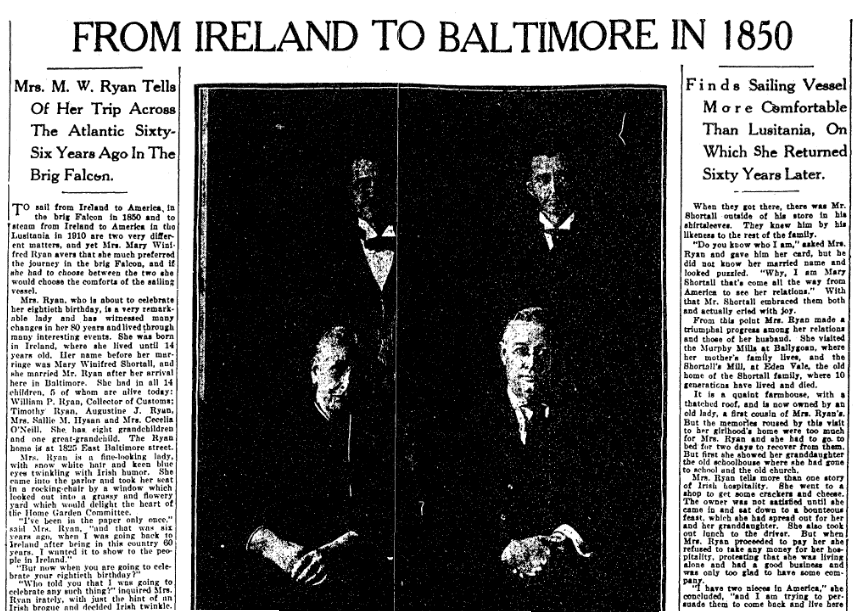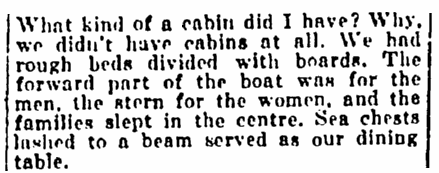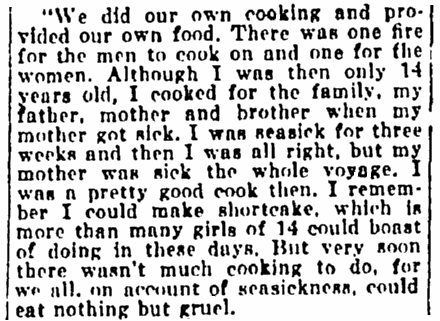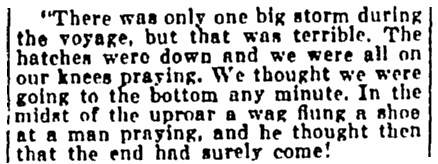I wanted to know about Mary Winifred (Shortall) Ryan’s trip to America as a 14-year-old with her family on board the brig Falcon in 1850. So I turned to GenealogyBank’s Historical Newspaper Archives to learn more.
I found a real treasure: Mary’s first-person account in a 1916 newspaper article.

This article was full of details about what that 1850 voyage across the Atlantic was like.
Cabin?
Why, we didn’t have cabins at all. We had rough beds divided with boards. The forward part of the boat was for the men, the stern for the women, and the families slept in the centre. Sea chests lashed to a beam served as our dining table.

Cooking
We did our own cooking and provided our own food.
Interesting. I never thought of how that worked. I guess I thought there was a centralized area where the ship’s crew cooked and provided the passengers and crew with their daily meals. I didn’t know that they had to bring enough food to last them for the nearly two-month voyage.
There was one fire for the men to cook on and one for the women. Although I was then only 14 years old, I cooked for the family, my father, mother and brother when my mother got sick… I was a pretty good cook then. I remember I could make shortcake, which is more than many girls of 14 could boast of doing in these days. But very soon there wasn’t much cooking to do, for we all, on account of seasickness, could eat nothing but gruel.

Terrible Storm
Mary remembered:
There was only one big storm during the voyage, but that was terrible. The hatches were down and we were all on our knees praying. We thought we were going to the bottom any minute. In the midst of the uproar a wag flung a shoe at a man praying, and he thought then that the end had surely come!

Did Mary’s family save this newspaper clipping and pass it down in the family? Did the family pass down her memories of the trip over to America, or her return voyage and experiences in County Wexford 60 years later? Does someone in the family still have the old family photo that was published in that 1916 newspaper article?
For too many of us the sad answer is no.
We know that the family came from Ireland or another country – and probably not much more than that.
It’s a good thing that GenealogyBank has been digitizing and putting online the nation’s newspapers from 1690 to today, ranging from passenger lists to articles like the one above and beyond. Now with nearly 2 billion records online, we can find the stories of our ancestors.
They are not lost.
It’s a Great Day for Genealogy!
Related Irish American Genealogy Articles:

Extremely interesting and informative article. I know the year my Irish ancestor came to the U.S. but no idea about the actual date. Was it common for immigrants to travel the Atlantic in the winter months? Or were there certain times of the year that were better for ocean travel? That might help me narrow down the time of year.
Thank you.
I’ve been searching for the arrivals of my ancestors’ journeys thanks to your webinar. Since you are probably a bit more familiar with these articles, maybe you can answer 2 questions for me:
Any idea what it means when they list a company at the end of the arrival announcement as “to”, such as “to W.P. Clyde & Co”?
Any tips to finding a list of passengers for that arrival, if there are any?
Nancy –
Tell us more – what was his name? Did he come over alone or with other family members? What year did he come over?
Passengers made the voyage throughout the year.
Tom
Barbara,
I would need to see the specific article to be sure – but the “to W.P. Clyde & Co” notation usually refers to cargo brought on board that ship that was being sent to that company.
If you’re not finding the name of your ancestor in the passenger lists in GenealogyBank – then you should also check for the passenger lists on FamilySearch (free site)
https://familysearch.org/search/collection/location/1?region=United+States+of+America
Tom
Hi, I was wondering how long these trips took. Thank you!